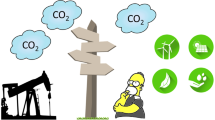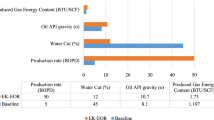Abstract
Water requirements for enhanced oil recovery (EOR) are thoroughly evaluated using publicly available information, data from actual field applications and information provided by knowledgeable EOR technologists in fourteen major oil companies. Water quanity and quality requirements are estimated for individual EOR processes (steam drive,in situ combustion and carbon dioxide, micellar-polymer, polymer and caustic flooding) in those states and specific geographical locations where these processes will likely play major roles in future petroleum production by the year 2000. The estimated quantity requirements represent thetotal water needed from all sources, e.g. aquifers, lakes and produced water. A reduction in these quantities can be achieved by reinjecting all of the produced water potentially available for recyle, e.g. some is lost in oil and water separation and water treatment processes, in the oil recovery method. For injection water quality requirements, it is noted that not all of the water used for EOR needs to be fresh. The use oftreated produced water can significantly reduce the quantities of fresh water that would be sought from other sources. Although no major EOR project to date has been abandoned because of water supply problems, competing regional uses for water, drought situations, and scarcity of high quality, e.g. low total dissolved solids, surface water and ground water could be impediments to certain projects in the near future.
Similar content being viewed by others
References
Leonard, J., ‘Annual production report: Steam dominates enhanced oil recovery’,Oil Gas J., 80 139 (5 April, 1982).
The Water Requirements of Selected Enhanced Oil Recovery Processes (unpublished), H.M. Mittelhauser Corp., (August 1979); quoted inEnergy Technologies and the Environmenta, Environmental Information Handbook prepared by Aerospace Corp. for US (DOE, DOE/EP0026) (June 1981).
Collins, A. G., and Wright C. C.,Enhanced Oil Recovery Injection Waters, Bartlesville Energy Technology Center, DOE/BETC/RI-82/5 (April 1982).
H. K. van Poollen and Associates, Inc.,Fundamentals of Enhanced Oil Recovery, Penn Well Pub. Co. (1980).
Farouq Ali, S. M., and Meldau, R. F., ‘Current steamflood technology’,J. Pet. Tech., 31, 1332–42 (October 1979).
Gates, C. F., and Brewer, S. W., ‘Steam injection into the D and E Zone, Tulare Formation, South Belridge Field, Kern County, California’,—ibid.,27, 343–8 (March 1975).
‘EOR water use is limited and worthwhile, Shell says’,Enhanced Recovery Week, 4 (23 November 1981).
Elias, R., Jr.,et al. ‘Steam generation with his TDS feedwater’ (paper SPE/DOE 8819), inFirst Joint SPE/DOE Symposium on Enhanced Oil Recovery, Tulsa, April 1980, pp 75–9.
Enhanced Oil Recovery, National Petroleum Council (December 1976).
Chu, C., ‘State-of-the-art review of fireflood field projects’ (paper SPE/DOE 9772), inSecond Joint SPE/DOE Symposium on Enhanced Oil Recovery, Tulsa, April 1981, pp 29–56.
Tertiary Oil Recovery: Potential Application and Constraints, Pacific Northwest Lab., PNL-RAP-25 (June 1978).
Stalkup, F. I., ‘Carbon dioxide miscible flooding: past, present and outlook for the future.J. Pet. Tech., 30, 1101–12 (August 1978).
Doscher, T. M., and El Arabi, M., ‘Scaled-model experiments show how CO2 might economically recover residual oil’,Oil Gas J., 80, 144–51 (12 April 1982).
Gogarty, W. B., ‘Status of surfactant or micellar methods’,J. Pet. Tech., 28, 93–102 (January 1976).
Bragg, J. R.,et al., ‘Loudon surfactant flood pilot test’ (paper SPE/DOE 10862), inThird Joint SPE/DOE Symposium on Enhanced Oil Recovery, Tulsa, April 1982. pp 933–52.
‘Exxon surfactants get 60% of residual oil’,Enhanced Recovery Week, 1 (12 April 1982).
Chang, H. L., ‘Polymer flooding technology yesterday, today, and tomorrow,’J. Pet. Tech., 30, 1113–28 (August 1978).
Kaplan, E., Garrell, M., Royce, B., Reidel, E. F., and Sathaye J.,Assessment of Environmental Problems Associated with Increased Enhanced Oil Recovery in the United States, 1980–2000, BNL 51528 (November 1981).
International Petroleum Encyclopedia, pp 257–73, Petroleum Pub. Co., Tulsa (1979).
Matheny, S. L., Jnr., ‘EOR methods help ultimate recovery’,Oil Gas J., 78, 79–124 (31 March, 1980).
Kaplan, E., Garrell, M. H., Riedell, E. F., and Sathaye, J.,Proc. DOE/Office of the Environment Workshop on Enhanced Oil Recovery: Problems, Scenarios, Risks, BNL 51406 (August 1980); Summary inOil Gas J., 79, 157–64 (October 1981).
Petroleum Data System of North America User's Guide, University of Oklahoma (February 1980).
Bartlesville Energy Technology Center Enhanced Oil Recovery Project Data Base. DOE/BETC/SP-82/6 (March 1982).
Author information
Authors and Affiliations
Rights and permissions
About this article
Cite this article
Royce, B., Kaplan, E., Garrell, M. et al. Enhanced oil recovery water requirements. Minerals and the Environment 6, 44–53 (1984). https://doi.org/10.1007/BF02072654
Issue Date:
DOI: https://doi.org/10.1007/BF02072654




